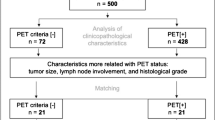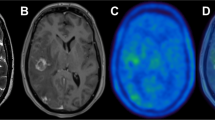Abstract
Purpose
Small-cell lung cancer (SCLC) is an aggressive disease, despite an initially favorable response to treatment, and its prognosis is still poor. Multiple parameters have been studied as possible prognostic factors, but none of them are reliable enough to change the treatment approach. 18F-fluorodeoxyglucose-positron emission tomography (FDG-PET) is a novel imaging technique for staging of SCLC. The aim of this study was to evaluate the prognostic value of pre-treatment FDG-PET parameters on clinical outcome in limited stage (LS) SCLC patients treated with curative thoracic radiotherapy (RT) and chemotherapy.
Methods
Clinical records of 46 LS-SCLC patients with pre-treatment FDG-PET imaging were retrospectively reviewed. Patients were treated with definitive RT for a total dose of 50–60 Gy and chemotherapy. The clinical endpoints were progression-free survival (PFS) and overall survival (OS).
Results
The median age was 59 (range 30–82) years, and median follow-up time was 23.2 months (range 5–82.8 months). Median OS was 30.9 months for pre-treatment tumor maximum standardized uptake value (SUVmax) <9.3 and 20.6 months for SUVmax ≥9.3 (p = 0.027) and PFS was 55.6 months for SUVmax <9.3 and 38.6 months for SUVmax ≥9.3 (p = 0.16). Median OS was 73 months for pre-treatment lymph node SUVmax <5.8 and 21 months for ≥5.8 (p = 0.01) and PFS was 38.6 months (range 6.8–70.3 months) for SUVmax-LN ≥5.8; all patients with SUVmax-LN <5.8 were alive (p = 0.07). Median survival time was 28.2 months (range 21.7–34.7 months) for patients younger than 65 and 8.7 months (range 5.7–11.8 months) for those ≥65 years (p = 0.00).
Conclusions
Pre-treatment FDG-PET uptake may be a valuable tool to evaluate prognosis in SCLC patients. Patients with a higher pre-treatment FDG uptake may be considered at increased risk of failure and may benefit from more aggressive treatment approaches.





Similar content being viewed by others
References
Byers LA, Rudin CM. Small cell lung cancer: where do we go from here? Cancer. 2015;121:664–72.
VanMeerbeeck JP, Fennell DA, De Ruysscher DKM. Small cell lung cancer. Lancet. 2011;378(9804):1741–54.
Parkin DM, Bray F, Ferlay J, Pisani P. Global cancer statistics, 2002. CA Cancer J Clin. 2005;55:74–108.
Micke P, Faldum A, Metz T, Beeh KM, Bittinger F, Hengstler JG, et al. Staging small cell lung cancer: Veterans Administration Lung Study Group versus International Association for the Study of Lung Cancer—what limits limited disease? Lung Cancer. 2002;37:271–6.
Turrisi AT, Kim K, Blum R, Sause WT, Livingston RB, Komaki R, et al. Twice-daily compared with once-daily thoracic radiotherapy in limited small-cell lung cancer treated concurrently with cisplatin and etoposide. N Engl J Med. 1999;340:265–71.
Socinski MA, Bogart JA. Limited-stage small-cell lung cancer: the current status of combined-modality therapy. J Clin Oncol. 2007;25:4137–45.
Paesmans M, Sculier JP, Lecomte J, Thiriaux J, Libert P, Sergysels R, et al. Prognostic factors for patients with small cell lung carcinoma: analysis of a series of 763 patients included in 4 consecutive prospective trials with a minimum follow-up of 5 years. Cancer. 2000;89:523–33.
Kamel EM, Zwahlen D, Wyss MT, Stumpe KD, von Schulthess GK, Steinert HC. Whole-body (18)F-FDGPET improves the management of patients with small cell lung cancer. J Nucl Med. 2003;44:1911–7.
Bradley JD, Dehdashti F, Mintun MA, Govindan R, Trinkaus K, Siegel BA. Positron emission tomography in limited-stage small-cell lung cancer: a prospective study. J Clin Oncol. 2004;22:3248–54.
Vinjamuri M, Craig M, Campbell-Fontaine A, Almubarak M, Gupta N, Rogers JS. Can positron emission tomography be used as a staging tool for small-cell lung cancer? Clin Lung Cancer. 2008;9:30–4.
von Schulthess GK, Steinert HC, Hany TF. Integrated PET/CT: current applications and future directions. Radiology. 2006;238:405–22.
Buck AK, Herrmann K, Stargardt T, Dechow T, Krause BJ, Schreyögg J. Economic evaluation of PET and PET/CT in oncology: evidence and methodologic approaches. J Nucl Med. 2010;51:401–12.
Lee YJ, Cho A, Cho BC, Yun M, Kim SK, Chang J, et al. High tumor metabolic activity as measured by fluorodeoxyglucose positron emission tomography is associated with poor prognosis in limited and extensive stage small cell lung cancer. Clinl Cancer Res. 2009;15:2426–32.
Zhu D, Ma T, Niu Z, Zheng J, Han A, Zhao S, et al. Prognostic significance of metabolic parameters measured by (18)F-fluorodeoxyglucose positron emission tomography/computed tomography in patients with small cell lung cancer. Lung Cancer. 2011;73:332–7.
Oh JR, Seo JH, Chong A, Min JJ, Song HC, Kim YC, et al. Whole-body metabolic tumour volume of 18F-FDG PET/CT improves the prediction of prognosis in small cell lung cancer. Ear J Nucl Med Mol Imaging. 2012;39:925–35.
Park SB, Choi JY, Moon SH, Yoo J, Kim H, Ahn YC, et al. Prognostic value of volumetric metabolic parameters measured by [18F]Fluorodeoxyglucose-positron emission tomography/computed tomography in patients with small cell lung cancer. Cancer Imaging. 2014;14:2.
Kim MH, Lee JS, Mok JH, Lee K, Kim KU, Park HK, et al. Metabolic burden measured by (18)F-fluorodeoxyglucose positron emission tomography/computed tomography is a prognostic factor in patients with small cell lung cancer. Cancer Res Treat. 2014;46:165–71.
Delbeke D, Coleman RE, Guiberteau MJ, Brown ML, Royal HD, Siegel BA, et al. Procedure guideline for tumor imaging with 18F-FDG PET/CT 1.0. J Nucl Med. 2006;47(5):885–95.
Garg MK, Glanzman J, Kalnicki S. The evolving role of positron emission tomography–computed tomography in organ-preserving treatment of head and neck cancer. Semin Nucl Med. 2012;42(5):320–7.
Avallone A, Aloj L, Caracò C, Delrio P, Pecori B, Tatangelo F, et al. Early FDG PET response assessment of preoperative radiochemotherapy in locally advanced rectal cancer: correlation with long-term outcome. Eur J Nucl Med Mol Imaging. 2012;39(12):1848–57.
Adli M, Kuzhan A, Alkis H, Andic F, Yilmaz M. FDG PET uptake as a predictor of pain response in palliative radiation therapy in patients with bone metastasis. Radiology. 2013;269(3):850–6.
Halfpenny W, Hain SF, Biassoni L, Sherman JA, McGurk M. FDG-PET: a possible prognostic factor in head and neck cancer. Br J Cancer. 2002;86(4):512–6.
Allal AS, Dulguerov P, Allaoua M, Haenggeli CA, el El-Ghazi A, Lehmann W, et al. Standardized uptake value of 2-[(18)F] fluoro-2-deoxy-d-glucose in predicting outcome in head and neck carcinomas treated by radiotherapy with or without chemotherapy. J Clin Oncol. 2002;20(5):1398–404.
Vansteenkiste JF, Stroobants SG, Dupont PJ, De Leyn PR, Verbeken EK, Deneffe GJ, et al. Prognostic importance of the standardized uptake value on (18)F-fluoro-2-deoxy-glucose-positron emission tomography scan in non-small-cell lung cancer: an analysis of 125 cases. Leuven Lung Cancer Group. J Clin Oncol. 1999;17(10):3201–6.
Takeda A, Yokosuka N, Ohashi T, Kunieda E, Fujii H, Aoki Y, et al. The maximum standardized uptake value (SUVmax) on FDG-PET is a strong predictor of local recurrence for localized non-small-cell lung cancer after stereotactic body radiotherapy (SBRT). Radiother Oncol. 2011;101(2):291–7.
Oshida M, Uno K, Suzuki M, Nagashima T, Hashimoto H, Yagata H, et al. Predicting the prognoses of breast carcinoma patients with positron emission tomography using 2-deoxy-2-fluoro[18F]-d-glucose. Cancer. 1998;82(11):2227–34.
Brun E, Kjellén E, Tennvall J, Ohlsson T, Sandell A, Perfekt R, et al. FDG PET studies during treatment: prediction of therapy outcome in head and neck squamous cell carcinoma. Head Neck. 2002;24(2):127–35.
Allal AS, Slosman DO, Kebdani T, Allaoua M, Lehmann W, Dulguerov P. Prediction of outcome in head-and-neck cancer patients using the standardized uptake value of 2-[18F]fluoro-2-deoxy-D-glucose. Int J Radiat Oncol Biol Phys. 2004;59(5):1295–300.
Bonner JA, Sloan JA, Shanahan TG, Brooks BJ, Marks RS, Krook JE, et al. Phase III comparison of twice-daily split-course irradiation versus once-daily irradiation for patients with limited stage small cell lung carcinoma. J Clin Oncol. 1999;17:2681–91.
Herrmann MK, Bloch E, Overbeck T, Koerber W, Wolff HA, Hille A, et al. Mediastinal radiotherapy after multidrug chemotherapy and prophylactic cranial irradiation in patients with SCLC treatment results after long-term follow-up and literature overview. Cancer Radiother. 2011;15:81–8.
Miller KL, Marks LB, Sibley GS, Clough RW, Garst JL, Crawford J, et al. Routine use of approximately 60 Gy once-daily thoracic irradiation for patients with limited-stage small-cell lung cancer. Int J Radiat Oncol Biol Phys. 2003;56:355–9.
Spiro SG, James LE, Rudd RM, Trask CW, Tobias JS, Snee M, et al. Early compared with late radiotherapy in combined modality treatment for limited disease small-cell lung cancer: a London Lung Cancer Group multicenter randomized clinical trial and meta-analysis. J Clin Oncol. 2006;24:3823–30.
Pandit N, Gonen M, Krug L, Larson SM. Prognostic value of [18F]FDG-PET imaging in small cell lung cancer. Ear J Nucl Med Mol Imaging. 2003;30:78–84.
Onitilo AA, Engel JM, Demos JM, Mukesh B. Prognostic significance of 18F-fluorodeoxyglucose—positron emission tomography after treatment in patients with limited stage small cell lung cancer. Clin Med Res. 2008;6:72–7.
Kim SJ, Chang S. Limited prognostic value of SUVmax measured by F-18 FDG PET/CT in newly diagnosed small cell lung cancer patients. Oncol Res Treat. 2015;38:577–85.
Aupérin A, Arriagada R, Pignon JP, Le Péchoux C, Gregor A, Stephens RJ, et al. Prophylactic cranial irradiation for patients with small-cell lung cancer in complete remission. Prophylactic Cranial Irradiation Overview Collaborative Group. N Engl J Med. 1999;341:476–84.
Slotman B, Faivre-Finn C, Kramer G, Rankin E, Snee M, Hatton M, et al. Prophylactic cranial irradiation in extensive small-cell lung cancer. N Engl J Med. 2007;357:664–72.
Ulger S, Demirci NY, Aydinkarahaliloglu E, Kahraman FC, Ozmen O, Erdogan Y, et al. PET-CT guided curative conformal radiation therapy in limited stage small cell lung cancer. J Thorac Dis. 2015;7(3):295–302.
Author information
Authors and Affiliations
Corresponding author
Ethics declarations
Conflict of interest
Author Meryem AKTAN declares that she has no conflict of interest. Author Mehmet KOC declares that he has no conflict of interest. Author Gul KANYILMAZ declares that she has no conflict of interest. Author Berrin BENLI YAVUZ declares that she has no conflict of interest.
Ethical approval
All procedures performed in studies involving human participants were in accordance with the ethical standards of the institutional and/or national research committee and with the 1964 Helsinki declaration and its later amendments or comparable ethical standards.
Informed consent
Informed consent was obtained from all individual participants included in the study.
Rights and permissions
About this article
Cite this article
Aktan, M., Koc, M., Kanyilmaz, G. et al. Prognostic value of pre-treatment 18F-FDG-PET uptake in small-cell lung cancer. Ann Nucl Med 31, 462–468 (2017). https://doi.org/10.1007/s12149-017-1178-z
Received:
Accepted:
Published:
Issue Date:
DOI: https://doi.org/10.1007/s12149-017-1178-z




